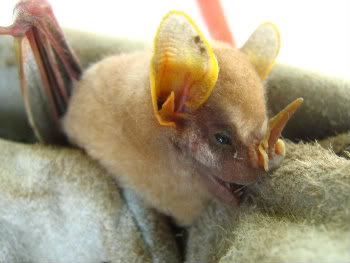Solitary fruit-eating bat
Artibeus incomitatus is a species of subgenus Dermanura the authentics fruit Vampire bats. You only occurs on only 4 km ² of Escudo de Veraguas isolated island in the Caribbean Sea off Panama and is very closely related to Artibeus watsoni.
Description
A. incomitatus is very similar to the type A. watsoni, but is significantly greater (10% bigger size [ 59.7 to 54.2 mm] and 6 % longer skull [ 20.9 to 19.6 mm] ) and severe ( ~ 15 % [13 to 11.2 g ] ), even the smallest specimens are in the body measurements outside the range of variation of A. watsoni. The animals have long shaggy - two colored dorsal fur - mostly in the umbra, but color variations between Rußfarben and a rich brown are known. The underside is lighter, usually colored in sepia. The animals have cream-colored drawings on the edges of the ear, as well as bright stripes in the face, but they are pronounced pronounced only at less than half of the individuals to the White. The outer extremities are hairy. The skull is robust and large, the Rostrum broad, deep and Böge shaped.
Teeth
The I1 have equal points, the rear cutting the P4 are notched usually little and weak. M1 is broad with large outer tubercles, the missing M3 very often.
Behavior
Little is known about the behavior of Artibeus incomitatus, except that they are frugivorous. He eats in contrast to the neighboring species of the genus Artibeus from a wider selection of fruits. There, however, the major food source for fruit Vampire of the mainland, figs missing.
Dissemination
Artibeus incomitatus comes only on the 4 -acre isolated islands Escudo de Veraguas ago, on this, the species is, however, widespread - with a higher population density than Artibeus watsoni on the mainland and neighboring islands - and in all habitats, both the coconut plantations, the swampy lowlands and on the low hills ( about 50 m) and the mangrove (sea level) encountered. Artibeus incomitatus is the only fruit -eating bat on Escudo de Veraguas.
Parasites
A previously undescribed bat fly the Streblidae family that is closely related to the type Paratrichobius lowei the sister Fruchtvampirart Artibeus watsoni, lives as endoparasite on Artibeus incomitatus.
Endangering
Artibeus incomitatus is by the IUCN due to its low circulation area - his home island covers just 3.4 square kilometers - as threatened with extinction ( critically endangered ) classified.
Evolution and systematics
Artibeus incomitatus has evolved from a Artibeus - watsoni -like bat that has significant Inselgigantismus the type within about 9,000 years, to the small size of Escudo de Veraguas and the lack of competition for food with simultaneous widespread lack of figs, one of the main food sources of Artibeus - watsoni populations returned. The classification as a separate species and not a subspecies of Artibeus watsoni is justified by the large morphological differences; even the smallest adult specimens are larger than the range of variation of Artibeus watsoni; In addition, there are significant differences in the structure of the teeth, especially the lower M2.
Name
The specific epithet comes from the Latin and means incomitatus alone, unaccompanied and is derived from the isolation of the population of other Artibeus species.










